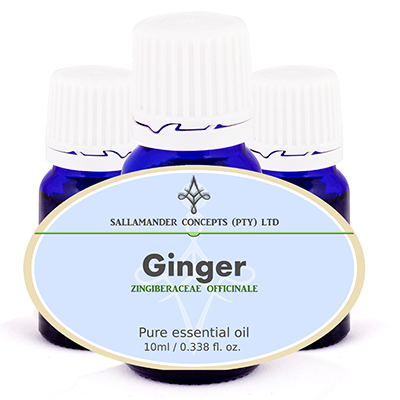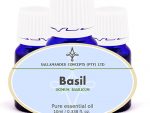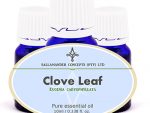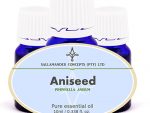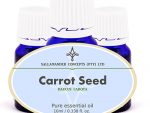Information on Ginger essential oil
Ginger essential oil is extracted from the plant Zingiberaceae officinale of the Zingiberaceae family and is also known as Common or Jamaica Ginger.
Ginger Essential Oil’s warming properties are often used for digestive problems, as well as nausea – be that morning sickness or travel upset. It is also of value when treating colds and flu and especially for catarrh lung conditions and rheumatic pain. It can also be used on the skin to help clear bruises.
Oil Properties
Ginger oil can vary in color from pale yellow to a darker amber color and the viscosity also ranges from medium to watery. It is a strong smelling oil – spicy, sharp, warm and with a hint of lemon and pepper, which smells of actual ginger.
Origin
The plant is said to originate from India, China and Java, yet is also native to Africa and the West Indies. It was most likely brought to Europe between the 10th and 15th century as a condiment and spice.
Ginger is a perennial herb and grows to about 3 – 4 feet high with a thick spreading tuberous rhizome. Every year it shoots up a stalk with narrow spear-shaped leaves, as well as white or yellow flowers growing directly from the root.
It has been used as a medicine since very early times and is recorded in both Sanskrit and Chinese texts and is also mentioned in the literature of the ancient Greeks, Romans, and Arabians.
Asian medicine uses dried ginger for stomach problems such as stomach-ache, diarrhea, and nausea. The Chinese also use it to boost the heart and to help with mucus and phlegm.
The name ginger is said to be derived from the Gingi district in India, where tea made from ginger is used for stomach upsets.
Extraction
The oil is extracted by means of steam distillation from the unpeeled or dried, ground-up root (rhizome) of the plant, and can yield about 2 – 4 % oil.
Chemical composition
The essential oil has various chemical constituents including the following: Zingiberene, ar-Curcumene, β-Sesquiphellandrene, Camphene, β-Bisabolene, β-Phellandrene
Precautions
Ginger essential oil is generally regarded as safe (it has GRAS status).
Please read our page with heading: Safety with Essential Oils before using this oil.
We recommend the following book as an excellent resource regarding safety:
Essential Oil Safety: A Guide for Health Care Professionals by Robert Tisserand & Rodney Young (#ad)
Therapeutic properties
The therapeutic properties of Ginger essential oil are analgesic, anti-emetic, antispasmodic, bactericidal, carminative, cephalic, expectorant, febrifuge, laxative, rubefacient, stimulant, stomachic, sudorific and tonic.
Uses
Ginger essential oil is used in the treatment of fractures, rheumatism, arthritis, bruising, carbuncles, nausea, hangovers, travel and sea sickness, colds and flu, catarrh, congestion, coughs, sinusitis, sores on the skin, sore throat, diarrhea, colic, cramps, chills and fever.
Burners and vaporizers
In vapor therapy, it can be used to help relieve catarrh, lethargy, nausea, colds, flu, feeling of loneliness and loss of libido.
Blended Massage Oil or in the Bath
In blended massage oil or diluted in the bath, it can be used for arthritis, rheumatism, lethargy, nausea, colds and flu, muscle aches, poor circulation and digestive upsets.
Blended in a Cream
As a part of a cream or lotion it can be used for arthritis, muscle aches, rheumatism, and also to help with poor circulation and to disperse bruises
Hot Compress
When used with hot compresses, ginger oil can be used for arthritis, rheumatism, muscle aches and digestive upsets.
Drop on a Handkerchief
For ease of use, when applying a drop of oil to a handkerchief for quick inhalation, it can be used for nausea, morning sickness, indigestion, colds and flu and travel sickness.
Suggested Dilution Rates
On the skin
Adult:
Face: 0.5% to 1.5%
Body: 1.5% to 3%
Bath: 1.5% to 4%
3 to 24 months:
Face: 0.25% to 0.5%
Body: 0.25% to 0.5%
Bath: Maximum of 0.5%
2 to 6 years:
Face: 0.5% to 1.5%
Body: 0.5% to 2%
Bath: 0.5% to 2%
6 to 15 years
Face: 0.5% to 1.5%
Body: 0.5% to 3%
Bath: 0.5% to 3%
Pregnancy
Face: 0.5% to 1.5%
Body: 0.5% to 2%
Bath: 0.5% to 2%
- When in doubt consult your doctor / medical professional before use.
- Most professionals and/or Aromatherapists will always err on the side of safety when giving advice regarding the use of essential oils and oleo resins during pregnancy.
- Quite a number of Aromatherapists advise that you should avoid all essential oils completely while pregnant, specifically during the first trimester. This is a very safe approach but may not be necessary at all.
Diffusers and Vaporisers
4 to 8 drops
General:
- When using for the first time – Always use the lowest dilution rate and build up slowly to the maximum. Stop using all essential oils on the skin if irritation or allergy occurs.
- Any advice or instruction received from a medical professional ALWAYS supersedes recommendations or advice found on this website. When in doubt consult your doctor / medical professional.
Summary
Ginger essential oil is well suited to help ease colds and flu, nausea, motion sickness, morning sickness, muscle aches and pains, as well as poor circulation and arthritic pain.
Its warming qualities are good to use for feelings of loneliness and winter depression, and its energizing properties are said to make it a good aphrodisiac.
Blends
Since ginger oil is strong smelling, it can overpower weaker oils, but blends well with all citrus and spicy oils such as Bergamot, Frankincense, Neroli, Rose, Sandalwood (Mysore) and Ylang-ylang.

